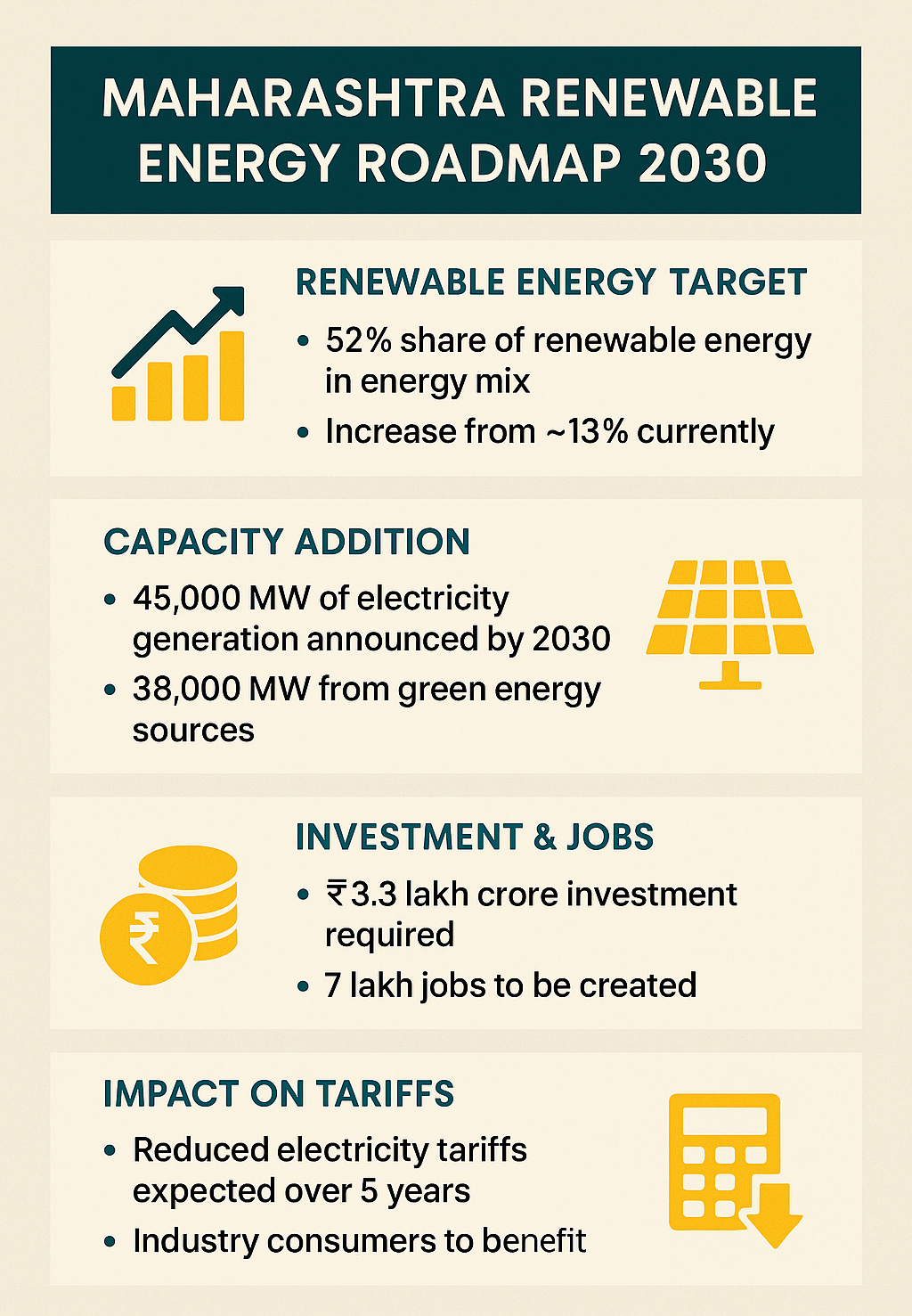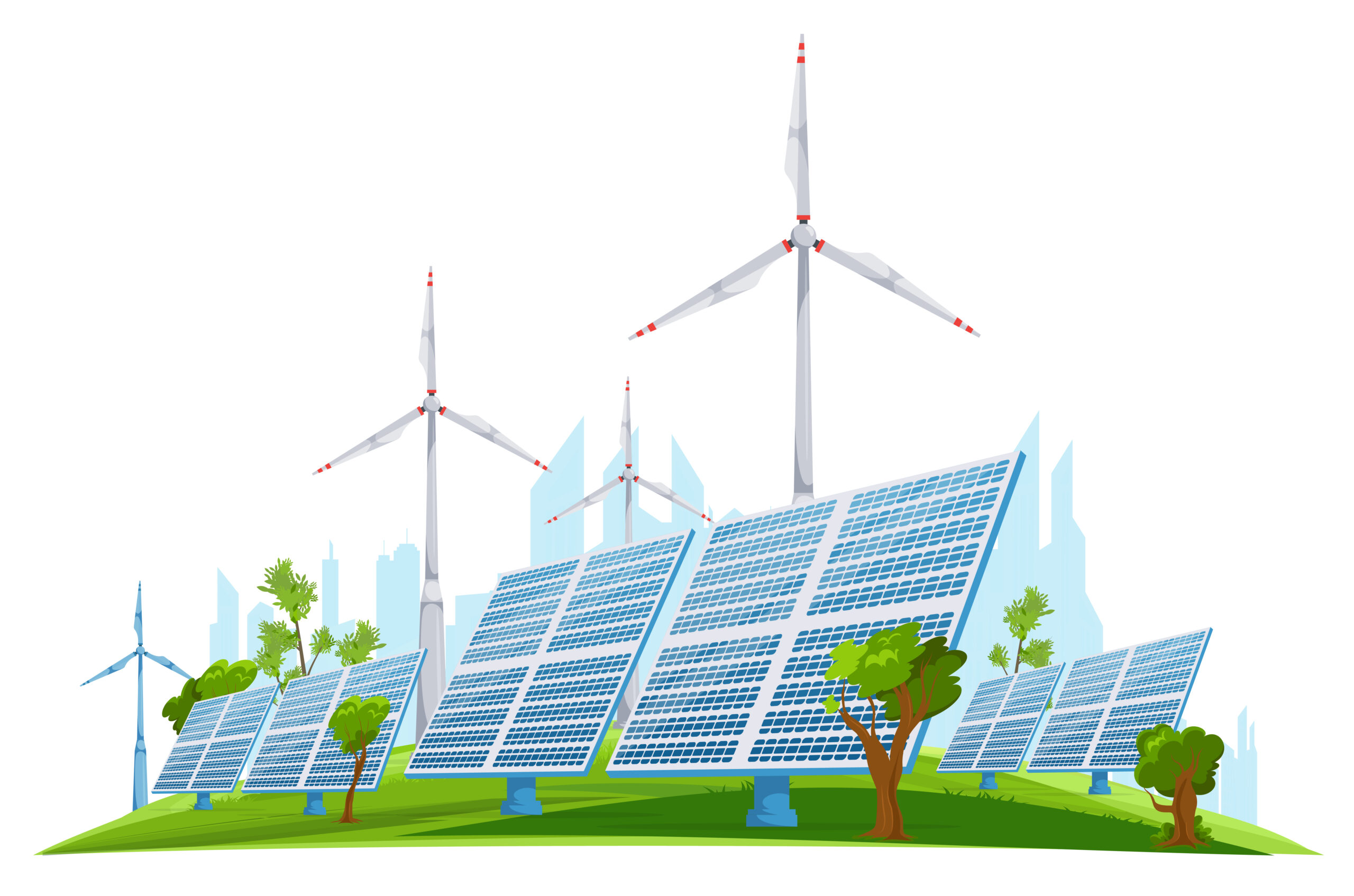Introduction: A Turning Point in Maharashtra Renewable Energy Story
Maharashtra, India’s industrial powerhouse, is rewriting its electricity roadmap. With power demand surging and climate concerns growing, the state is embracing renewable energy as a cornerstone of its future. The Maharashtra Electricity Regulatory Commission (MERC) has recently approved two major renewable energy procurement proposals from the state utility, Maharashtra State Electricity Distribution Company Ltd. (MSEDCL).
The first is a landmark deal to source 1,475 MW of solar power from NHPC Ltd at ₹2.60 per unit for 25 years. The second involves 780 MW of wind-solar hybrid power from NTPC at competitive tariffs of ₹3.42–₹3.43 per unit. Together, these decisions mark a critical step towards Maharashtra’s ambitious plan to raise its renewable energy share from the current 13% to 52% by 2030.
But this is not just a policy announcement it is a transformation that could lower power bills for 3 crore consumers, attract industries, generate lakhs of jobs, and cement Maharashtra’s place at the forefront of India’s clean energy revolution.

Solar Power Deal with NHPC: A Game-Changer at ₹2.60 per Unit
MSEDCL’s decision to procure 1,475 MW of solar power from NHPC is significant for several reasons. The tariff of ₹2.60 per kWh is among the lowest for large-scale solar in India today. To put this in perspective, many thermal power plants still supply electricity at costs exceeding ₹4 per unit.
By locking in this solar tariff for 25 years, Maharashtra ensures long-term price stability for a major portion of its supply. Unlike coal or gas-based plants, solar has no fuel cost, which means consumers are shielded from global fuel price volatility.
This procurement will also contribute directly to fulfilling Maharashtra’s Renewable Purchase Obligation (RPO), which mandates state utilities to source a specific portion of their power from green energy.
Wind-Solar Hybrid from NTPC: Adding Stability to the Grid
In addition to solar, MERC has also greenlit MSEDCL’s proposal to procure 780 MW of wind-solar hybrid power from NTPC. Hybrid projects combine solar and wind generation, helping to balance fluctuations in supply.
Solar power peaks during the day, while wind energy often complements it at night or during monsoon months. By blending the two, hybrid projects offer more consistent generation compared to standalone solar or wind.
The approved tariff of ₹3.42–₹3.43 per unit (including trading margin) is slightly higher than solar-only projects but still competitive. More importantly, it enhances reliability for MSEDCL’s supply mix, which is vital for meeting the needs of industries and households alike.
MERC’s Role: Balancing Costs and Long-Term Growth
The Maharashtra Electricity Regulatory Commission has played a crucial role in enabling these procurements. By carefully evaluating the bids, tariffs, and power purchase agreements, MERC ensures that deals serve both consumer interests and long-term sustainability goals.
In its approval, MERC also highlighted the importance of coordination with the State Transmission Utility (STU) to ensure that the required transmission lines and substations are ready on time. Without strong transmission infrastructure, even the cheapest power cannot reach consumers. If necessary, MERC has urged government intervention to resolve bottlenecks swiftly.
Maharashtra’s Renewable Energy Vision for 2030
The recent approvals are part of a much larger plan. Maharashtra has announced its intention to achieve 45,000 MW of power generation by 2030, of which 38,000 MW will come from green sources like solar, wind, hydro, and hybrid projects.
This transition will require investments of around ₹3.3 lakh crore across generation, transmission, and distribution infrastructure. But the returns are enormous: not only will it reduce long-term electricity costs, but it is also expected to create nearly 7 lakh jobs across construction, manufacturing, operations, and allied sectors.
By 2030, if these goals are achieved, Maharashtra will have one of the highest renewable energy shares among Indian states, aligning itself with national climate goals while boosting its economy.
Impact on Consumers: Lower Bills Ahead
For Maharashtra’s nearly 3 crore electricity consumers, the shift to cheaper renewable energy offers direct financial relief. As MSEDCL replaces costlier power sources with low-cost solar and hybrid supply, the average procurement cost will decline.
In the short term, this means reduced upward pressure on tariffs. Over the next five years, as more green power enters the grid, MSEDCL officials expect electricity tariffs to drop further. For industries, this is especially important. Affordable power will make Maharashtra more attractive to investors, encouraging new factories, IT parks, and businesses to set up operations in the state.
Economic and Industrial Benefits
The renewable push is not just about green energy—it is about economic competitiveness. Industries such as steel, cement, automobiles, and IT are highly sensitive to power costs. By reducing tariffs, Maharashtra can position itself as a preferred destination for industrial investment.
Additionally, global supply chains are increasingly favoring regions that use clean energy. Many multinational companies now require their suppliers to reduce carbon footprints. With a 52% renewable share by 2030, Maharashtra can attract climate-conscious investors and become a hub for green manufacturing.
Challenges in Implementation
While the vision is ambitious, challenges remain:
- Transmission Infrastructure – Without timely upgrades to transmission lines and substations, new renewable capacity may face curtailment. Coordination between MSEDCL, STU, and central agencies will be critical.
- Land Acquisition – Large-scale solar and wind projects require significant land. Securing land without displacing communities or harming ecosystems is a delicate balancing act.
- Integration of Variable Renewables – Solar and wind are intermittent. To ensure grid stability, investments in energy storage and flexible generation sources will be needed.
- Policy Continuity – Renewable energy projects span decades. Stable policies and regulatory clarity are essential to maintain investor confidence.
- Consumer Awareness – Consumers must be made aware of how renewable procurement lowers costs, to build support for long-term energy reforms.
Environmental and Social Benefits
Beyond economics, these projects bring immense environmental and social gains. By displacing fossil fuel-based generation, Maharashtra will reduce its carbon emissions, contributing to India’s climate commitments under the Paris Agreement.
Cleaner air, reduced coal imports, and lower dependence on fossil fuels also mean better public health outcomes and improved energy security. Furthermore, the creation of 7 lakh jobs will provide livelihoods across both rural and urban areas, especially in project construction and maintenance.
The Road Ahead: What to Expect in the Next 5 Years
Over the next half-decade, Maharashtra will witness rapid changes in its power sector. With more renewable projects being commissioned, tariffs are expected to stabilize and decline gradually. Transmission upgrades will play a decisive role in ensuring smooth integration.
The state will also likely explore energy storage solutions such as battery storage and pumped hydro to complement its renewable fleet. Meanwhile, industries will benefit from affordable and sustainable electricity, making Maharashtra more globally competitive.
Conclusion
MERC’s approval of MSEDCL’s deals with NHPC and NTPC is a watershed moment in Maharashtra’s clean energy journey. With 1,475 MW of solar power at just ₹2.60 per unit and 780 MW of hybrid power at ₹3.42–3.43 per unit, the state is laying the foundation for cheaper, cleaner, and more reliable electricity.
By 2030, Maharashtra’s goal of achieving 52% renewable energy could reshape its economy, cut consumer bills, generate jobs, and make it a national leader in the green transition. The challenges are real, but so are the opportunities. If implemented well, this move could be remembered as the turning point that made Maharashtra’s power sector greener, stronger, and more affordable for all.
Reference: The Times of India
Also Read: India’s Renewable Energy Growth 2025 Surges 56%: A Massive Leap Toward 2030 Targets
